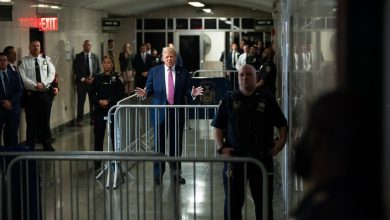The S&P 500 falls into correction territory with its sharpest daily drop in a year.

Wall Street was hit with a frenzied wave of selling on Monday, headed for its biggest drop in nearly a year, as investors were rattled by the prospect that the Federal Reserve might have to remove its support for the economy much faster than expected to combat inflation.
The S&P 500 fell more than 2.3 percent. The selling triggered a new marker of the abrupt shift in investor thinking this month: The index has now fallen more than 10 percent from its Jan. 3 record. A drop of that scale, called a correction on Wall Street, is an infrequent occurrence. The last time the S&P 500, the U.S. benchmark, was in a correction was March 2020, when a panic over the emerging coronavirus pandemic gripped global markets.
Technology stocks, which have been on the leading edge of the market decline this year, were walloped again on Monday: The tech-heavy Nasdaq composite slid more than 4.5 percent. The Nasdaq had already crossed the correction threshold last week and is now down 17 percent from its November high.
The Dow Jones industrial average was down 2.4 percent on Monday, its seventh-straight day of losses, and has dropped more than 9 percent since its peak on Jan. 4.
This downdraft has come as investors anticipate the Fed will have to raise interest rates quickly this year as it tries to tamp down inflation, which is at its highest level in 40 years. Its main policy interest rate, the federal funds rate, was slashed to near-zero in 2020 as the central bank took extraordinary measures to shore up the economy as it was hit by lockdowns. Those low rates also helped fuel a massive rally in stock prices.
Now that the Fed is likely to take away that support, investors are rethinking their expectations for corporate profits and what they’re willing to pay for stocks. Higher borrowing costs for houses and cars could slow spending and dampen consumer demand as borrowers direct more of their earnings to paying back debt.
“You’re starting to see a shift in psychology,” said John Canavan, an analyst at Oxford Economics. The Fed will hold a policy meeting on Tuesday and Wednesday, and while there probably won’t be any significant changes in the central bank’s policy, the attention on the meeting “focuses markets on the broader fact that the Fed is prepared to aggressively remove accommodation they hadn’t expected just a few months ago,” Mr. Canavan said.
The first interest rate increase — likely raising the benchmark by a quarter of a percentage point — could come as soon as March, economists expect, with some investors expecting three more to follow later in the year.
That’s a change in outlook since last year, when the Fed first said it would begin to remove some of its support for the economy. Analysts have also noted that the Omicron variant of the coronavirus has proved less of a threat to growth than investors might have expected last year — allowing the Fed to focus on controlling inflation, rather than boosting growth.
But investors also may have gotten carried away with their concerns over what might happen next, said Gennadiy Goldberg, a senior U.S. rates strategist at T.D. Securities.
Mr. Goldberg said the market was “starting to overshoot” and noted that some investors on Monday were discussing outcomes that the Fed hadn’t indicated, like a large rate increase in March or other rapid moves to choke off inflation, including the possibility of a rate increase at every meeting from now on. “I wonder how much of that is scaring the market,” he said.
The drop on Monday also came amid rising concerns about tension between Russia and Ukraine that pulled European stock benchmarks sharply lower. The White House is considering deploying thousands of U.S. troops, as well as warships and aircraft, to NATO allies in the Baltics and Eastern Europe, in what would be a major shift from its restrained stance on Ukraine. On Sunday, the State Department ordered all family members of U.S. embassy personnel in Kyiv to leave Ukraine, citing the threat of Russian military action.
Heightened tension in the region threatens Europe’s energy supply, because Russia provides the continent with more than 40 percent of its natural gas and 25 percent of its oil. Fears of a disruption come as Europe is already gripped by an energy crunch, with soaring natural gas prices caused by short supplies.
The Stoxx Europe 600 and the Dax in Germany both slid 3.8 percent on Monday. The two indexes are down about 8 percent from highs in early January.
Jeanna Smialek and Jeff Sommer contributed reporting.




